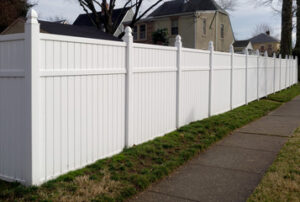The Benefits of Residential Fencing
If you’re interested in improving the aesthetic appeal of your home, you might want to consider adding a residential fence. These fences can have several benefits, including noise reduction, increased property value, and appeasing neighbors. But before installing residential fences, it’s important to know your local building codes. A fence designed according to your area’s building codes is a good idea for many reasons. Read on to find out more about the benefits of installing residential fences.

Before installing a fence, make sure you know what codes and restrictions are in your area. You don’t want to break the law after you have installed it, so research the local code and restrictions first. By following these guidelines, you can ensure that your fence is up-to-code and safe. There are many options for residential fencing, so choose wisely. If you want a fence to protect your property and family, consider contacting Fencing. You’ll be glad you did. And as always, you can count on the services of a professional fence installer.
The most popular style of residential fences is the solid surface type. These fences are made from boards that are nailed tightly together. This makes it nearly impossible to look inside the space, but people tend to buy welcoming and decorative fences. Solid surface fencing is the most secure type of residential fencing. A solid surface fence will prevent unwanted visitors from getting in. Many styles are available, so you should look online to find one that works for you.
Besides privacy, residential fences also provide security. They keep unwanted people and animals out. They also provide additional protection in case of a break-in, which is especially important for families with small children. Having a fence also keeps wild animals out of your yard. For example, if you have a basketball hoop, you should consider installing a fence around it. Keeping free balls from rolling into your yard isn’t always practical, but it can help maintain your privacy.
Residential fencing codes vary from city to city and state to state. Make sure to get professional assistance for installation if you’re not sure about the regulations. Fences are not cheap, but they can help tie the landscape together. In addition, fences also provide security. Whatever type you choose, you’ll have a fence to complement the aesthetic appeal of your home. Just make sure to check out the local fencing contractors. They’ll assess your property to provide an accurate estimate.
While several types of residential fences are available, wood is an excellent choice for privacy fencing. Wood is an easy material to customize and paint and comes in various colors and textures. Wooden fencing can also be easily customized to match the exterior of your home or landscape. In addition to privacy fences, wooden fencing is also versatile in aesthetics. You can opt for a solid wooden fence or a good neighbor fence to divide your property from your neighbors.
Wooden fences offer a cozy atmosphere. They can be stained any color, and the lifespan of these fences is often around 20 years. With proper care, wood fences can even last for decades – and they’ll still look good after all that time. If you decide to install a wood fence, buy a premium stain. Premium stain protects against UV damage, water, rotting, and splitting. Also, consider pressure-treated lumber if you want a fence that won’t be prone to termites.
Split rail fencing may be a good choice if you want a fence that won’t cost you an arm and a leg. This kind of fencing is both dog and predator-proof and is inexpensive. However, you might need to hire a contractor to install it. Depending on your property’s size, you might spend more than expected for the project. However, if you want privacy, bamboo fencing is an eco-friendly option that’s also inexpensive and easy to install.
When deciding to install a fence, it’s important to know the local rules for residential fencing. First, you should check the location of the property line. This line is not the curb but the edge of the pavement. A residential fence must be at least five feet from the property line. In addition, the required front yard should be at least 40 feet away from the front property line. The exact distance between the street and the property line will vary from street to street.






